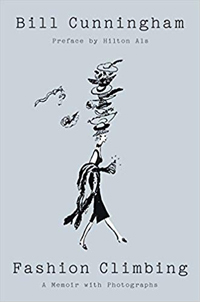 Bill Cunningham, Fashion Climbing: A Memoir with Photographs (New York: Penguin, 2018), 239pp.
Bill Cunningham, Fashion Climbing: A Memoir with Photographs (New York: Penguin, 2018), 239pp.
For the last thirty years of his long life, Bill Cunningham (1929–2016) bicycled around New York City in his trademark beret, royal blue French worker's jacket, and safety vest in order to photograph the fashions not just of the famous but of everyday people. Yes, he was entirely comfortable on the front row of the catwalks of New York and Paris, and at the philanthropic galas at the Met. But "the best fashion," he liked to say, "is on the street, always has been and always will be." Aficionados of the New York Times will remember his column called "On the Street." One week he might feature fanny packs, another week baggy or saggy pants, denim skirts, or bell bottoms. Cunningham never took money, owned a television, he refused all food and drink at galas, lived a monastic life in a microscopic studio until he was evicted, and attended church every Sunday.
After he died in 2016, his family discovered this surprise memoir among his papers. Although nobody knows for sure, the book seems to have been written before 1970; the last chronological reference is 1965. So, it's a sort of prequel to the documentary film Bill Cunningham New York (2010) that covers the last thirty years of his life as a photographer with the New York Times.
Cunningham's first memory of his lifelong obsession with fashion was when he was four years old, and his mother "beat the hell out of me" for parading around their middle-class Catholic home in his sister's dress, and "threatened every bone in my uninhibited body if I wore girls' clothes again." Nonetheless, despite this lifelong alienation from his family, "I knew my destiny was to create beautiful women and place them in fantastic surroundings… By the time I was twelve, the family was in a state of frenzy over how they could knock this artistic nature out of me." Thank God, they failed.
Cunningham got his start working in the stock room as a teenager at the upscale Bonwit Teller department store, and after that he never looked back. Bonwit obtained a scholarship for him to attend Harvard, but he hated school and left after two months. He moved to New York City, where for about fifteen years he operated a millinery business and outfitted wealthy women with outrageous hats. "These were truly happy times," he writes. But by about 1965, as the book ends, women had stopped wearing hats and so he closed the business. After a stormy stint writing for Women's Wear Daily (he had an annoying habit of being brutally honest about fashion), he would eventually join the New York Times.
Bill Cunningham was a preternaturally cheerful person: "I never had a mind that dwelt on the bad." He was enthusiastic and optimistic, and exuded gratitude for all his good fortune to do what he believed in. He never drank alcohol, as he hated the taste and the buzz. He loved flowers, and would decorate his dingy hotel rooms in Paris with them. For Cunningham, at its best, fashion was an expression of human joy rather than a means of social climbing or to impress others. He had a remarkably vivid imaginative life. His favorite pastime was people watching. Cunningham was also a famously private person, and the one disappointment in this book is that we learn almost nothing about his inner life. In fact, he says, after a life in the cut throat world of fashion, “The only way to last is never to let anyone really know you.” In that regard he also succeeded.


